1970s
1971
Eventide is Founded!
Eventide was founded by recording engineer Stephen Katz, inventor Richard Factor, and businessman/patent attorney Orville Greene. The business was originally a symbiote of the Sound Exchange, a recording studio located at 265 West 54th Street in New York City and owned by Greene. Since then, Eventide has become a ubiquitous name in audio broadcasting and recording, revolutionizing the industry with the H910 Harmonizer® special effects units, Instant Phaser®, and other groundbreaking products. Today, Eventide incorporates modern technology with more recent favorites like our award-winning stompboxes and plug-ins.

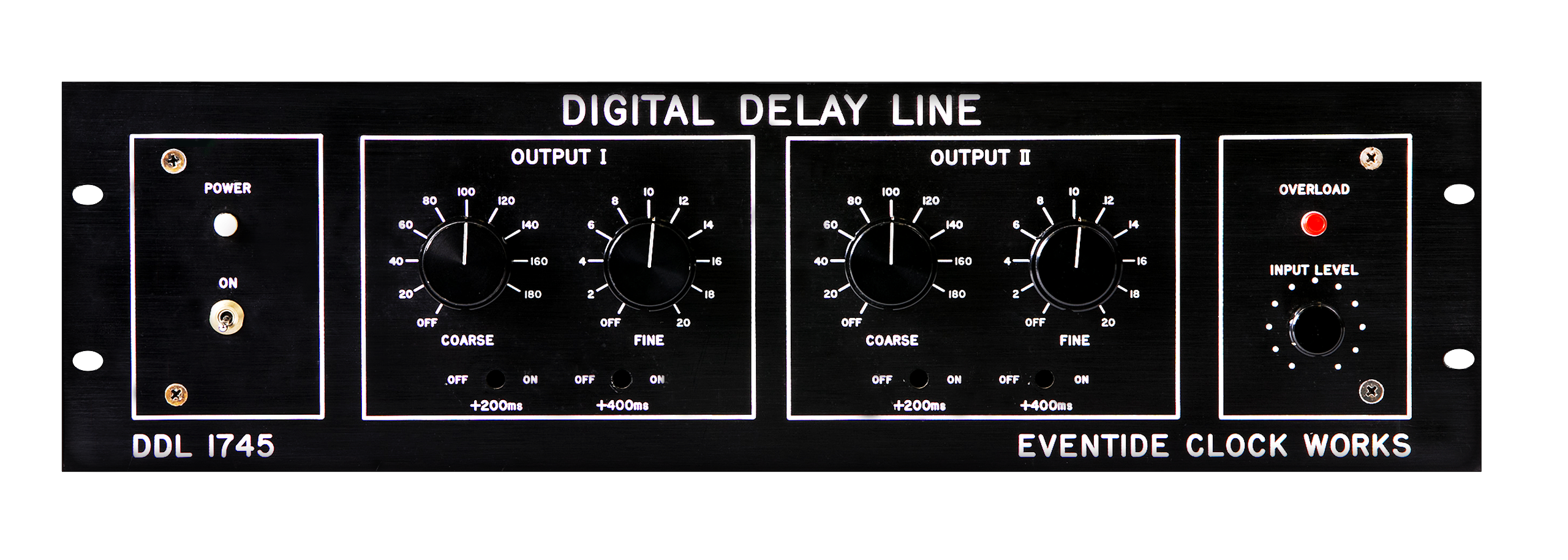
DDL 1745
The DDL 1745 is one of the earliest examples of rack-mount digital effects and the first studio digital delay. The digital delay line (DDL) was a clever way to achieve double-tracking and pre-delay for plate reverbs without the use of a tape machine at a time when the word digital was unheard of in studios. The DDL 1745 was also used in live sound applications, most notably Summer Jam 1973 at Watkins Glen. It allowed multiple sets of speaker towers to be spread hundreds of feet apart to provide the precise delay time needed to synchronize the delayed audio from the stage.

1972
Instant Phaser PS 101
The Instant Phaser was one of the first dedicated electronic effects units and Eventide’s first answer to tape flanging. The product became a studio favorite with engineers who used it to create stereo images from a single source, as well as more extreme uses like swept comb-filter effects which were similar to, yet distinct from, tape flanging. The Instant Phaser employed a series of eight, FET-based, carefully tuned analog all-pass filters which delivered lush phasing while preserving the original tone of the input signal.
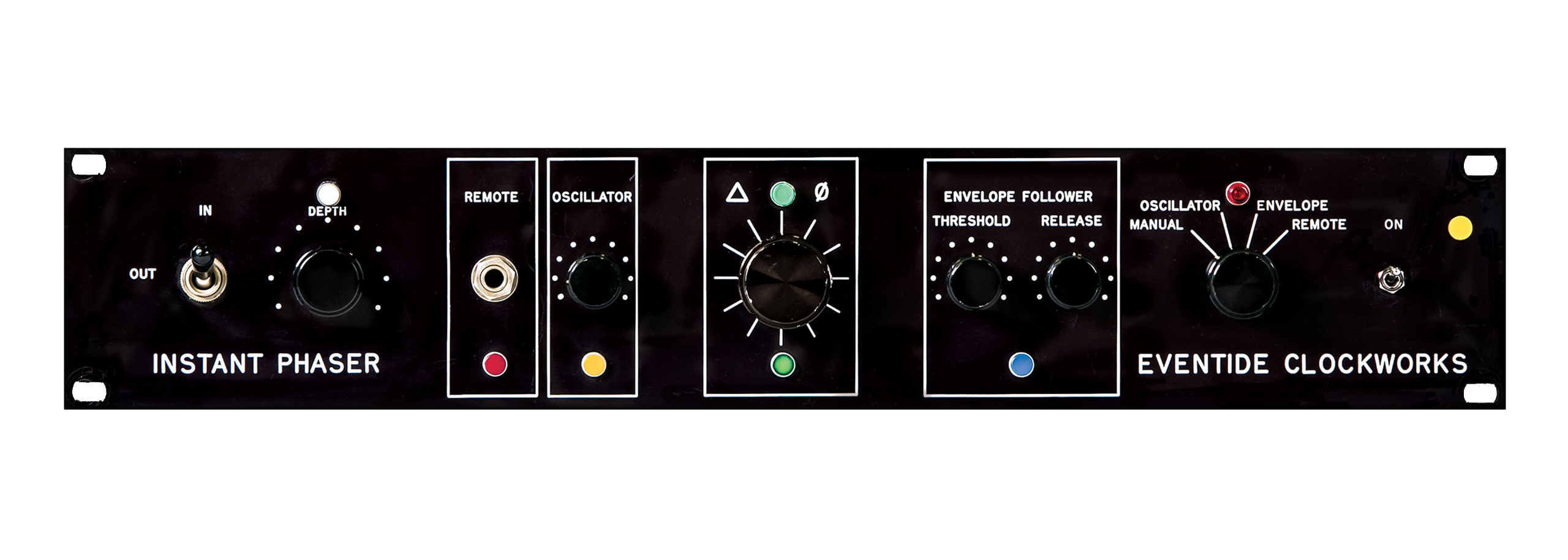
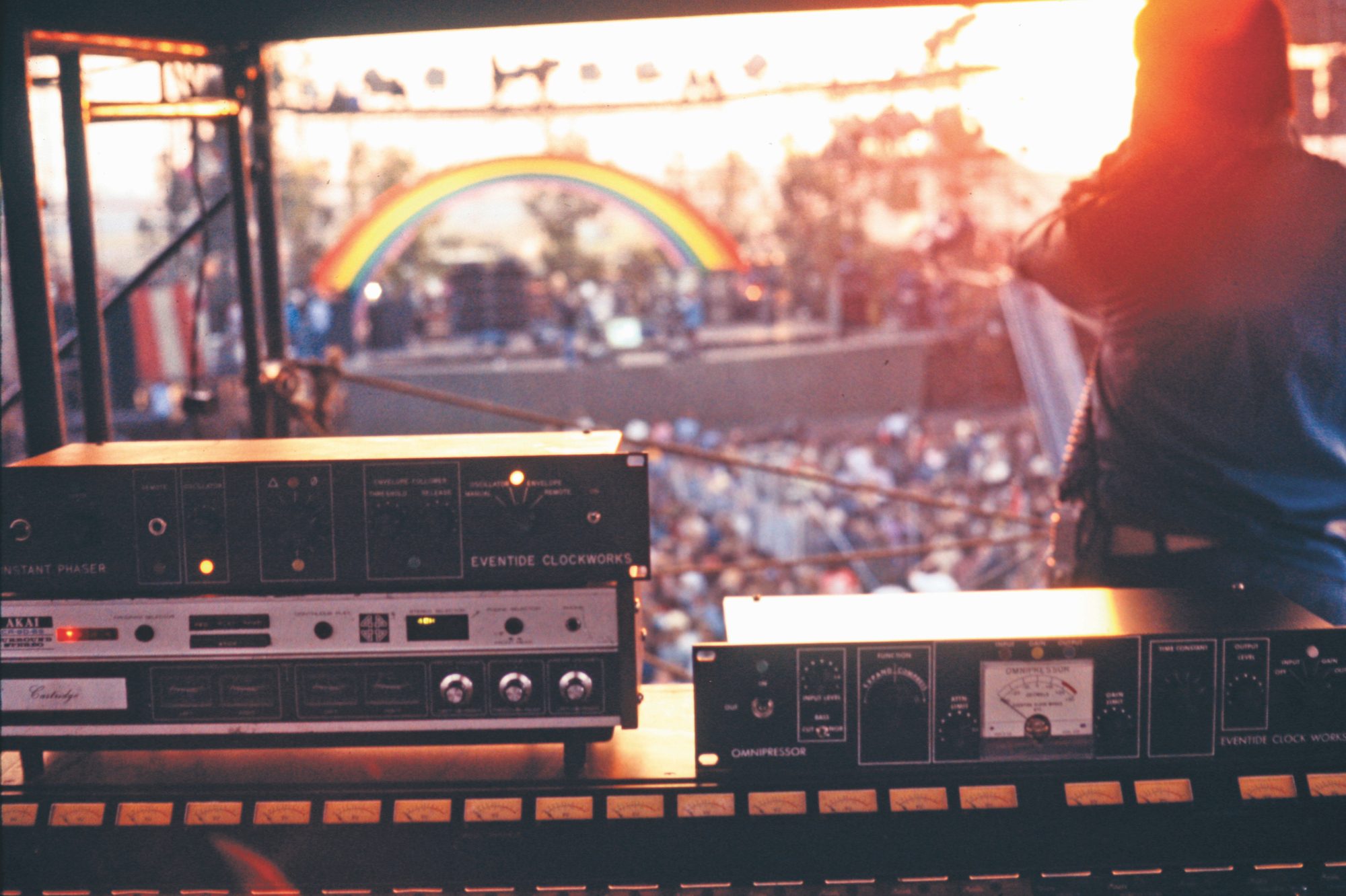
White Meter Omnipressor® (2826)
When the first Omnipressor was released, it was the earliest known instance of using lookahead compression in an audio device. The box suddenly made possible a completely new, wide range of dynamics effects. That said, the White Meter Omnipressor was particularly difficult to master due to its complicated user interface and controls. This resulted in it not being widely used in studios until the Black-Meter Omnipressor was released in 1974.
1973
DDL 1745A
The DDL 1745A addressed some of the shortcomings of the original DDL 1745. This included the loud (and dangerous) pop/crackle sound that was emitted every time a delay control switch was adjusted. To address this, Eventide designed its own shaft encoder (a new technology at the time) and the “Big Knob” was born. You could turn the knob slowly for fine control or spin it quickly for large changes. The Big Knob has since become a signature Eventide feature. The DDL 1745A also included new techniques such as Delay Doubling, Signal Recirculation, and special effects.
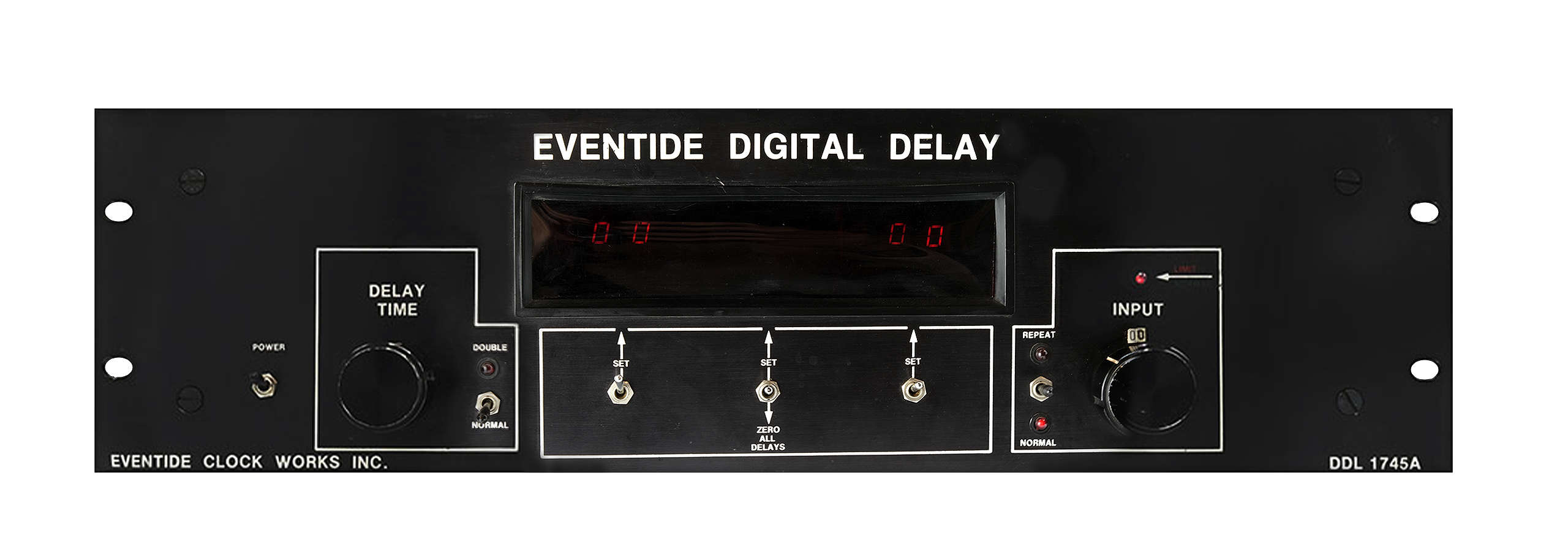
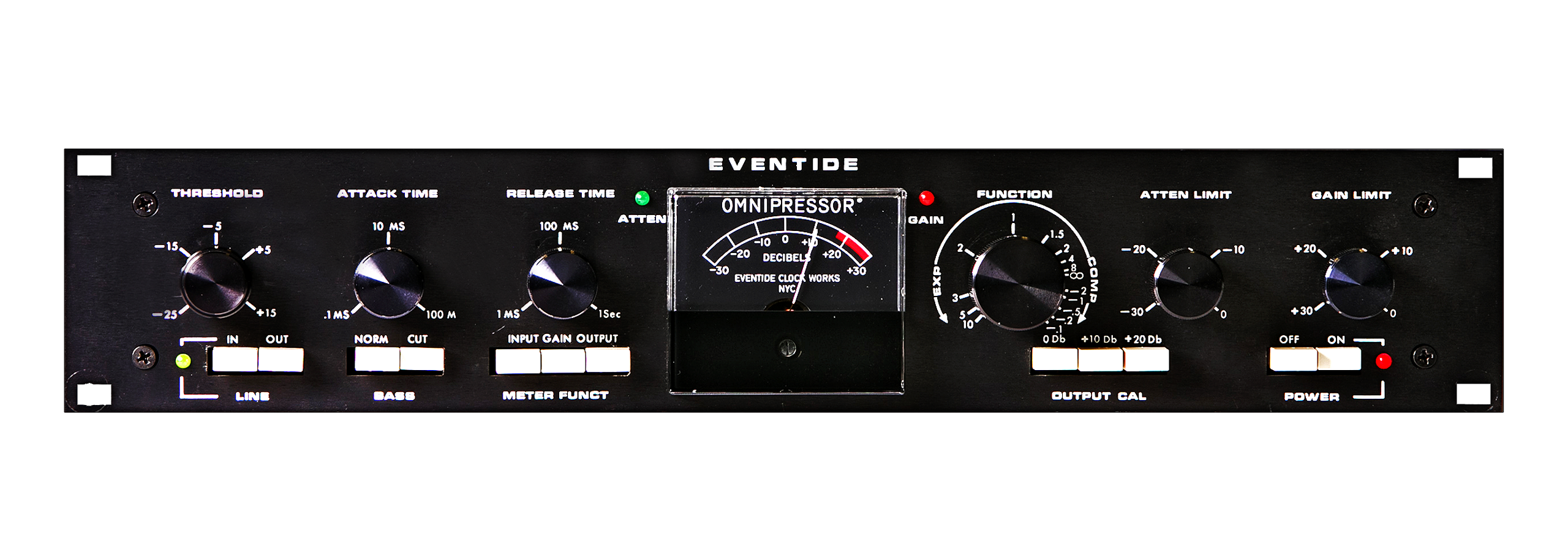
1974
Black Meter Omnipressor (2830)
The Black Meter Omnipressor included better functionality and calibrated knobs for fine tuning mixes. Former Eventide engineer Jon Paul rationalized the controls, which played a large role in making the Omnipressor a usable product. The device was notably used by studios and artists such as Brian May and Abba, among others. See this Gear Club excerpt with Eventide’s founder, Richard Factor, to learn more about the history of the Omnipressor!

H910 Harmonizer Introduced
After a pitch change option was introduced for the memory-based DDL 1745M, for the first time recording engineers could accomplish pitch change without resorting to tape. The stage was set for the development of an effects device that would forever change the world of music production: the Eventide Harmonizer. In 1974, Tony Agnello conceived of a pitch change processor but had little idea that he was creating a classic tool for the most successful artists of their generation.
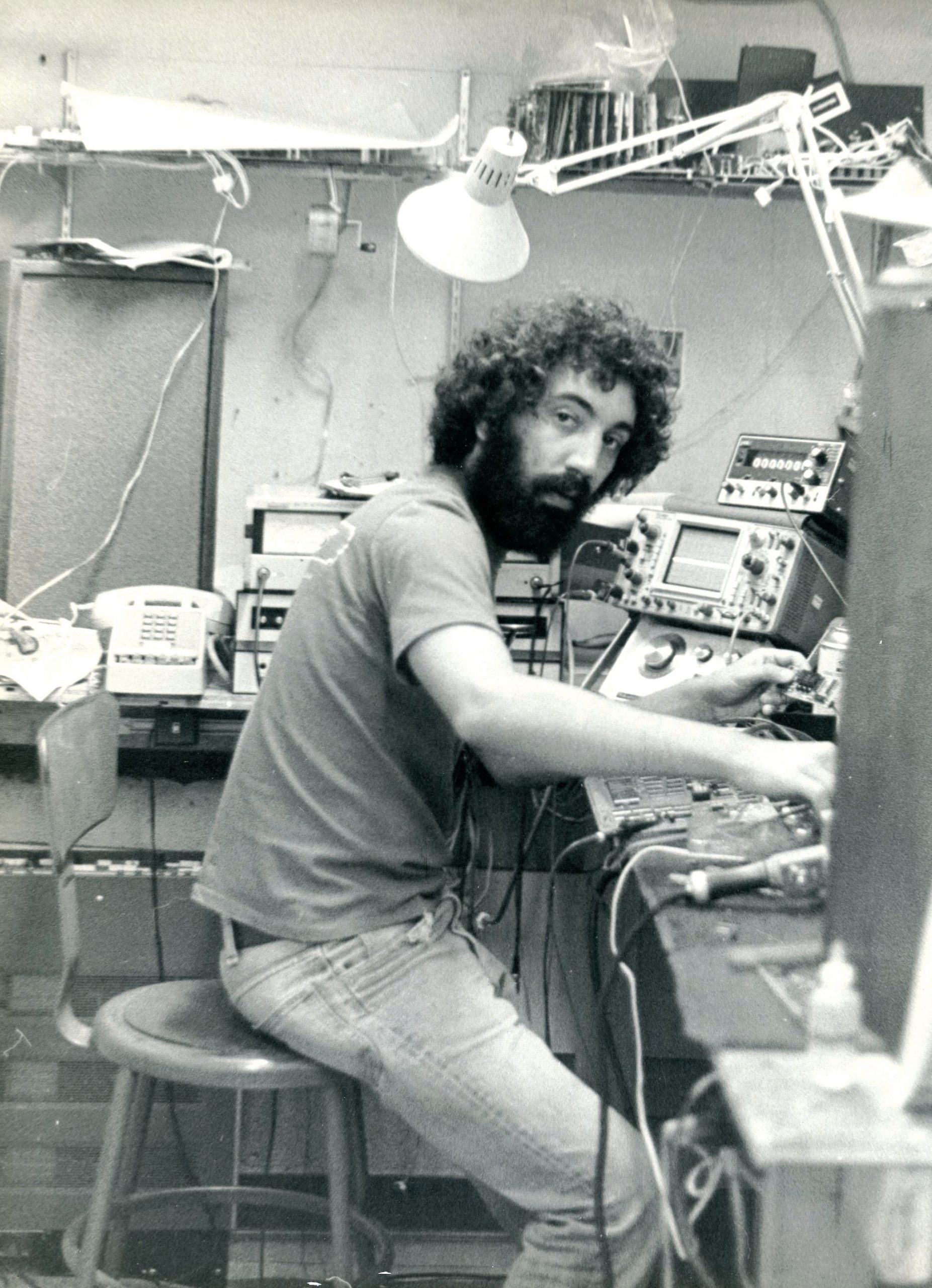

1975
H910 Harmonizer Becomes Commercially Available
The groundbreaking H910 Harmonizer changed the complexion of music, enabling engineers and artists to add texture to their recordings in ways that were unimaginable at the time. The H910 was the world’s first commercially available digital audio effects device; it combined pitch change with delay and feedback and could be controlled by a remote keyboard to instantly shift pitch in half steps. The H910 also featured a two-octave range and up to 112.5 msec of delay. The H910 opened up a new world of sonic possibilities which were exploited by artists like AC/DC and Frank Zappa. And, for worse or better, created the famous, audible ‘glitch’ which was caused by the splicing method of the delayed audio and embraced by artists like Laurie Anderson.
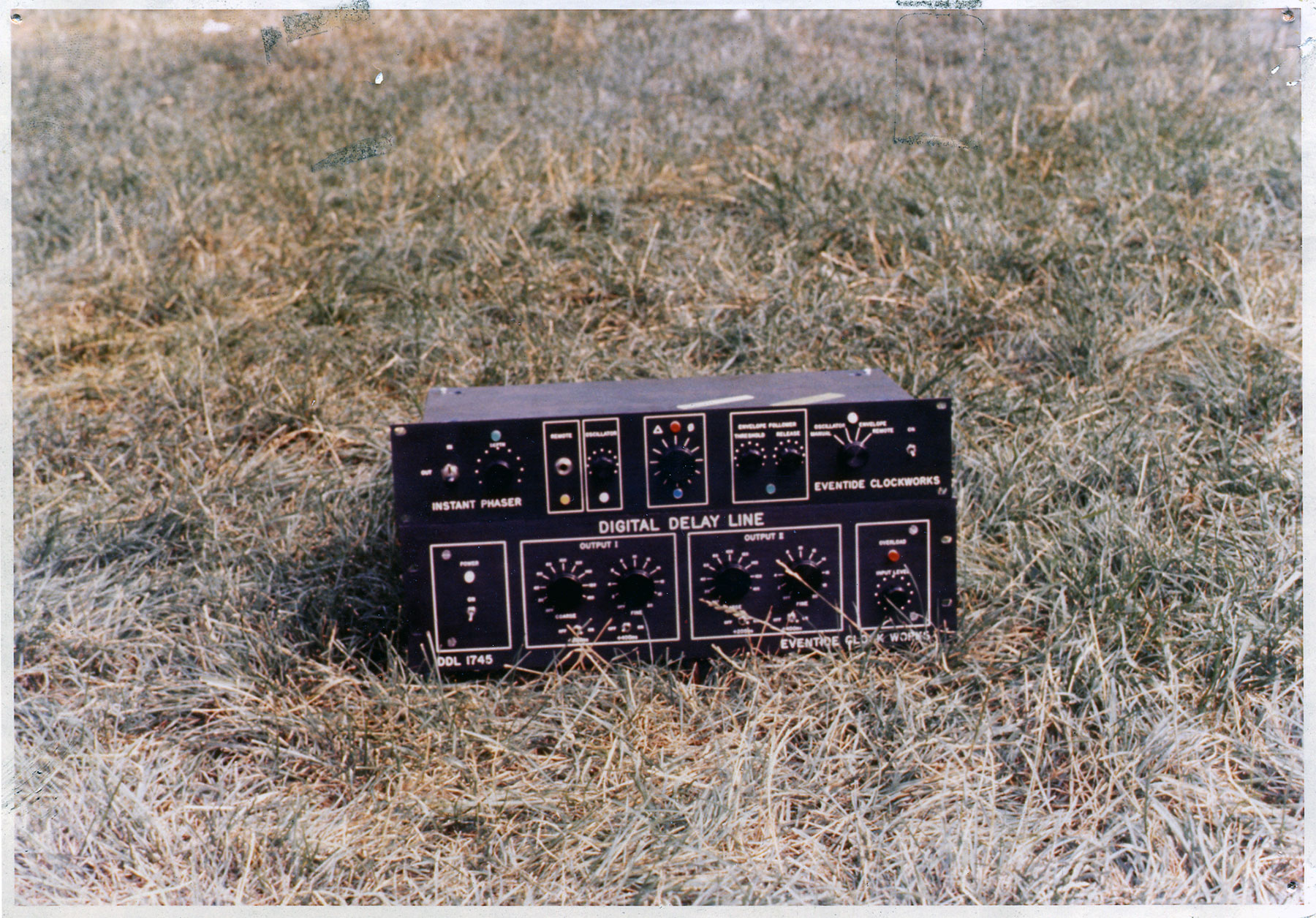
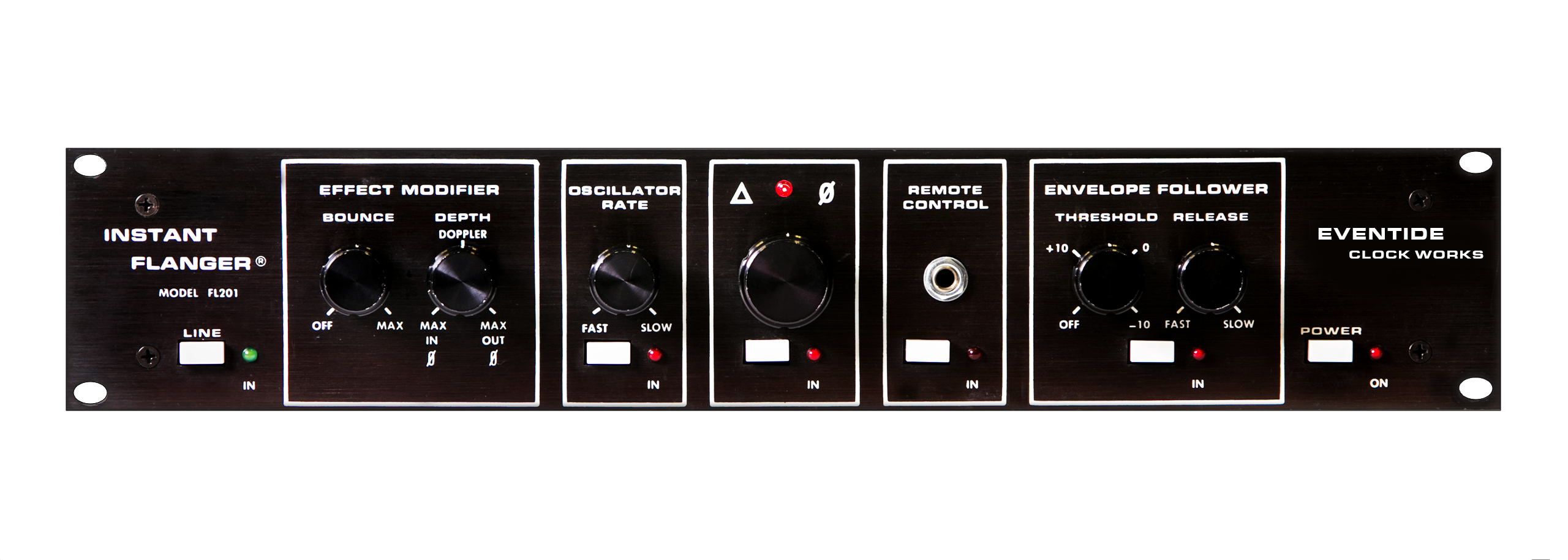
Instant Flanger FL 201
Thanks to the advances in bucket brigade chips in the mid ’70s, which made analog delay units possible, the Instant Flanger was able to go much further than the Instant Phaser to truly reproduce tape flanging. The Instant Flanger could create deeper flanging and more drastic and flexible effects than tape flanging ever could. Its iconic sound has been used on albums by Led Zeppelin, David Bowie, Jefferson Airplane, Cyndi Lauper and countless others.
DDL 1745M
The DDL 1745M (which stood for “Memory”) employed new, revolutionary Random Access Memory (RAM) chips to store and recall audio at will. RAM provided so many more options than the prior shift register-based delays; it was non-destructive, noiseless, and high-resolution. Not to mention the RAM ICs made the device much lighter! The 1745M came with 2 delay modules and the capability of adding up to 5 for turning single sources into a 5 voice chorus. It also came with a pitch change plug-in, and featured Double and Repeat functions, which made digital looping possible.


C200 Digital Modular Delay
The C200 Digital Modular Delay was released in 1975. It was a rack-mount unit offering low cost with multiple delays and output taps. The mainframe cost just $576. While not an effects unit, it was very versatile and used for sound reinforcement in large venues, like Yankee Stadium in New York City. It could be configured by the selection of plug-in modules, INPUT, TIMING, DELAY, OUTPUT and even a multi-channel pre-amplifier/mixer.
1977
BD955 The Broadcast Audio Delay
Specifically designed for policing live talk shows, the BD955 was our first “obscenity” broadcast delay unit. The BD955 made it possible for broadcasters to pre-screen material and delete any unwanted or obscene material before it could air, simply by pressing the big yellow “DUMP” button. As a RAM-based digital delay line, it was available in two frequency ranges, one for telephone audio and one for the full audio spectrum. It also had a unique “catch-up” feature to automatically rebuild the delay safety margin after unsuitable material had been dumped.


1978
HM80 Harmonizer
The HM80, designed by Richard Factor, was introduced as an “affordable” Harmonizer for the guitarist or keyboard musician to take on the road. It was the world’s first digital guitar FX device. It allowed users to perform time modification effects like Time Delay, Pitch Change, Reverb, Capture & Repeat, and Reversal in various combinations. Its features included guitar level in and out, as well as expression-pedal control of pitch and an auxiliary jack for switching the repeat function on/off. It predated the first BOSS digital guitar delay, which would be released five years later.
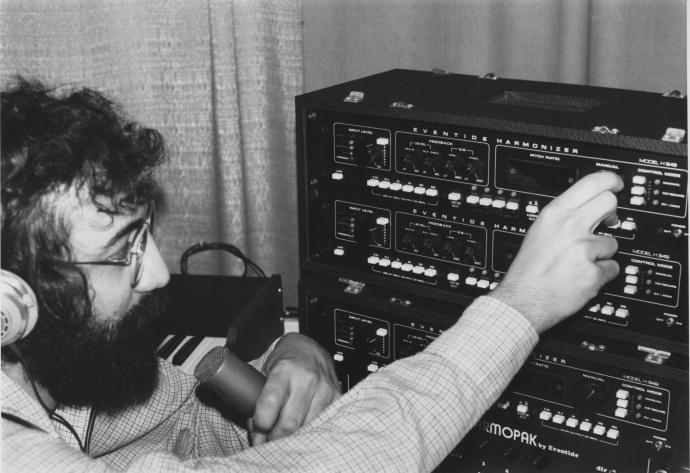

1979
H949 Harmonizer
We followed 1975’s H910 with the H949, the world’s first deglitched pitch change device. It used autocorrelation to analyze the audio and intelligently pick splice points that were inaudible. This Harmonizer was a combination digital delay line, pitch changer, and all-around special effects unit. Features like MicroPitch, Time Reversal, and Random delay were all firsts and made things like real-time tuning (long before Autotune) and double-tracking emulation possible.
Realtime Spectrum Analyzer THS-224
Before Eventide’s Realtime Spectrum Analyzer was released, spectrum analysis instruments were a bulky and expensive investment. The Spectrum Analyzer for the Commodore PET was a bolt-in card that turned the computer into a scientific instrument that measured the levels of 31 one-third octave bands. Not only was it affordable, it also made Eventide the first to turn a computer into a test instrument. Later analyzer models were released for Apple II and the Radio Shack TRS-80.

1980s
1982
SP2016 Signal Processor
The SP2016 was more than just a reverb, it was a digital effects processor with reverb, delays, EQ, modulation, and more. The goal was to create a digital processing unit that was fully programmable. The SP2016 innovated plug-in ROM chips which could be interchanged for different algorithms, thus coining the term “plug-in.” The SP2016’s reverbs spanned from small rooms to huge, unnatural spaces, and even included Selective Band Delays which could separate the signal into different frequency bands.
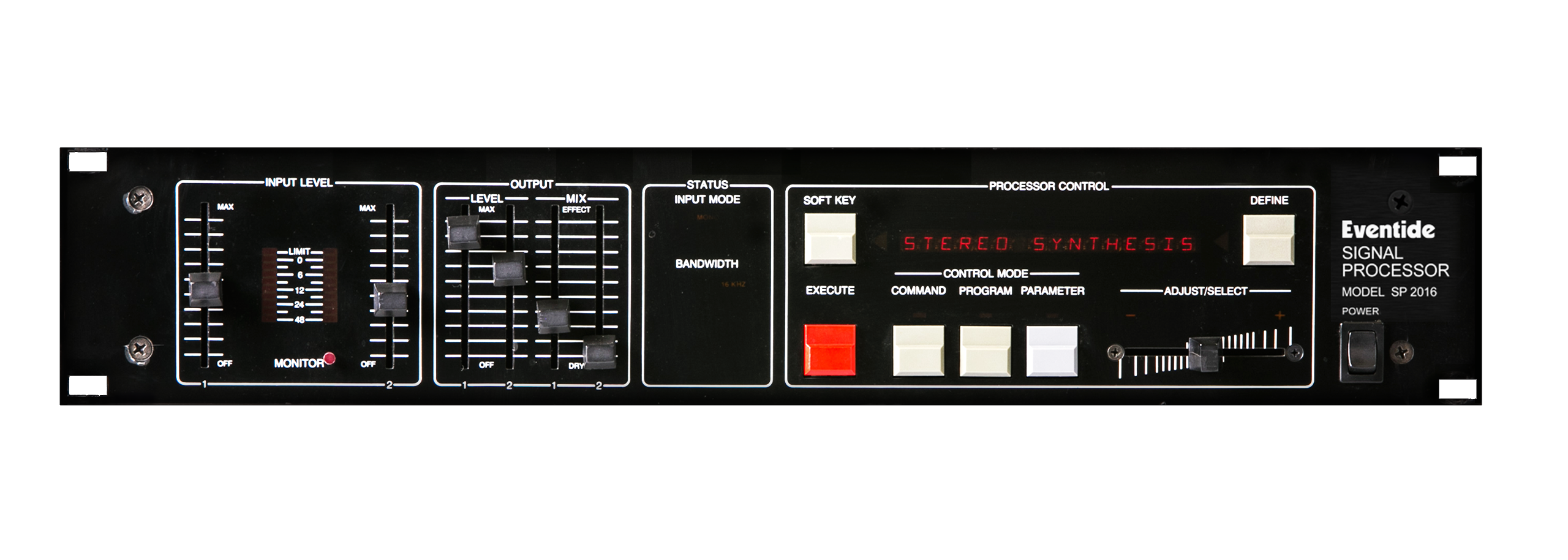

1984
H969 Harmonizer
The H969 Harmonizer built upon the H949, it introduced the new ProPitch digital electronic-splicing algorithm and also offered deglitching over a wider bandwidth – a full octave wider than previous units. Steve Vai had an H969 in his equipment setup during his time in Whitesnake, a unit he nicknamed the WOMANIZER.
BD980 Obscenity Delay
The BD980 Obscenity delay was the follow-up to the BD955 Broadcast Delay Unit. The BD980 featured new and improved catch-up circuity, making it faster and virtually undetectable, and using intelligent algorithm digital splicing techniques first applied in the Eventide Harmonizer effects units. The device offered two modes of catch-up, a Wait & Exit button for switching between remote broadcasts, time compression, and variable delays up to 10 seconds.


1987
H3000 Ultra-Harmonizer
The H3000 Ultra-Harmonizer introduced an entirely new range of features and effects to the Eventide Harmonizer line. With 11 effects algorithms and 100 presets, the H3000 was a truly intelligent pitch-changer and a programmable multi-effects unit with full stereo pitch-shifting, digital reverb, delays, modulation, and MIDI. It is known by many as the “holy grail” of multi-effects units. It also quickly became a go-to for guitarists, both in the studio and in their live racks, shaping the classic guitar sounds of artists like Van Halen.
Argus
The Argus 3000 Moving Map Display was Eventide’s venture into the world of aviation. As a newly licensed pilot himself, Richard Factor was surprised that no such moving map existed for private airplanes, so he created a system to improve situational awareness for pilots. Argus used graphic CRT displays to show the pilot where they were in relation to airports, special use airspaces, and navaids. The Argus system was a successful tool which remained in production for over two decades, with more advanced features in later models like the 5000, 7000, and the CE models which added color displays.
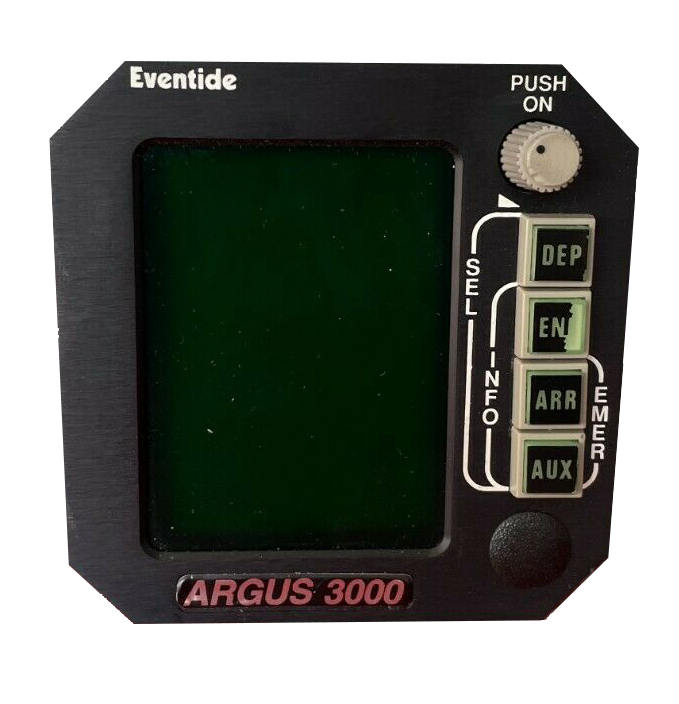
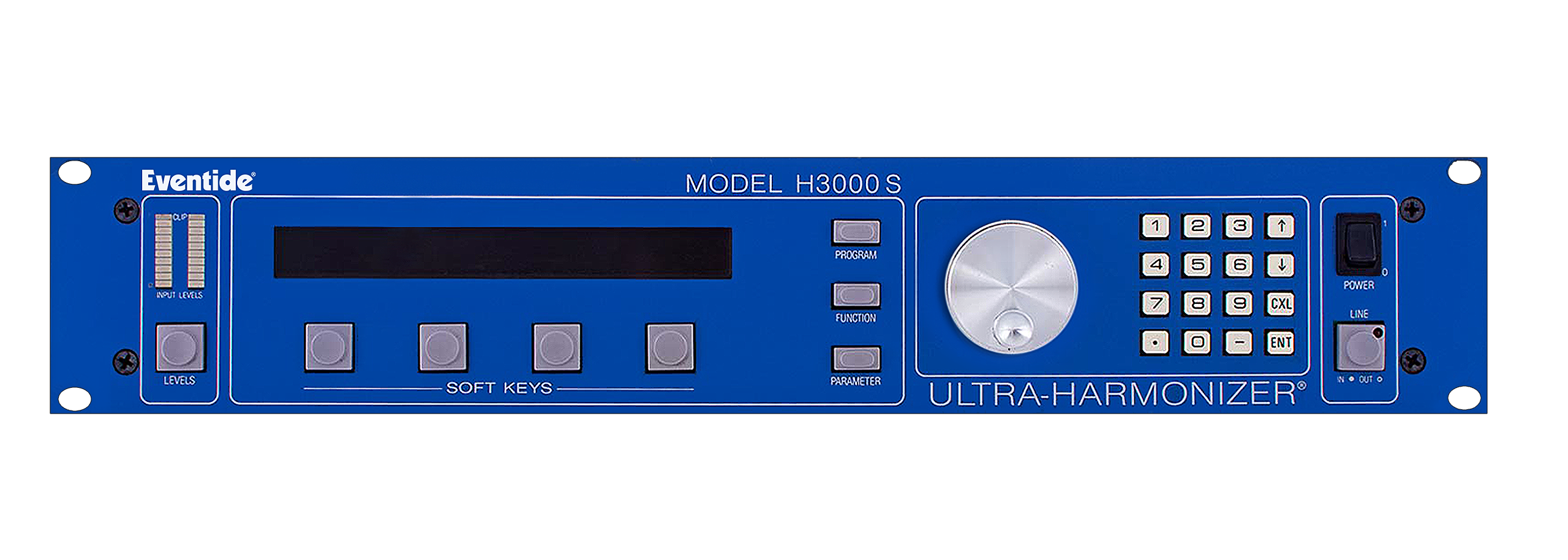
1988
H3000S Harmonizer
The second generation of the H3000 series, the H3000S Studio Ultra-Harmonizer, improved on the H3000 by adding even more presets and features. Being a huge fan of the original, guitarist Steve Vai contributed his own Preset Pack with 48 programs to this new model, highlighting its endless possibilities. In this equipment tour, Steve Vai shows off his H3000S and the H3000D/SX and DSP4000, but we’ll get to those later!
BD1000 Broadcast Video Delay
Using the technology of the BD980 for audio delay, the BD1000 introduced a video-oriented Broadcast Delay unit. The BD1000 could delay audio and video up to 8 seconds, streamlining the obscenity delay process.

1990s
1990
H3000B Harmonizer
The H3000B Broadcast Ultra-Harmonizer included new algorithms desgined for use in Broadcast, it included additional factory programs for broadcast use.



1994
DSP4000 and DSP4000B
The DSP4000 and DSP4000B were released as multipurpose programmable digital audio processors with pitch change capability. The effects were created by sound designer Jay Rose of DSE fame. They possessed greater processing power than ever, offered digital and analog I/O with preset storage on removable memory cards, the largest LCD display and easy to use controls. The Patch Editor allowed users to choose from over 90 effects modules and connect up to 40 in one preset, and the console could build reverb presets with up to four pitch shifts.
H3000B+/H3000B/LT
H3000D/SX
and H3000D/SE
The H3000B+ was a step up from the H3000B, with hundreds of voice and effects along with dense reverbs, pitch change programs, Timesqueeze, time compression/expansion, and more presets and algorithms. The H3000-B/LT Ultra-Harmonizer effects processor was identical to the H3000+, but without that unit’s Timesqueeze® algorithm and internal hardware for controlling tape machine speed.



1995
GTR4000 Harmonizer
The GTR4000 was released as the guitar version of the DSP4000. It was the world’s first no-compromise guitar effects processor and had many times the processing power of other guitar effects. It included an artist preset collection, the ability to create your own effects, and a “virtual pedalboard” where you could customize up to six simultaneous pedals, with instant on/off and parameter changes in real time – strapped via MIDI to your favorite MIDI foot controller.
BD1020 Broadcast Audio Delay
The BD1020 Digital A/V Delay was released as an economical and smaller delay product. Major cable and broadcast organizations like ABC, CBS, NBC, and FOX used the BD1020 to protect themselves from on-air obscenities and mistakes. The delay times ranged from 1.1 to twenty seconds.


1996
BD500 Broadcast Delay
The BD500 stereo delay added on to features from previous broadcast delays with enhancements such as adjusting the dump amount from 1 second up to the entire delay length in half-second increments. It also had a new “SNEEZE” function which momentarily “edits” audio entering the delay, allowing the host to sneeze, cough or make a short comment without being heard on air. Eventide’s exclusive catch-up and catch-down system (REBUILD and RAMP-TO-ZERO) and the exclusive fast entry and exit feature (WAIT-FOR-SAFE and WAIT-AND-EXIT) were also highlighted.
1998
DSP4500
The DSP4500 limited edition model was created after the DSP4000’s success. It came with every program preset found in the prior models…and then some. It included Alchemy 101, 225 new presets from Scott Gilfix and had the most program presets of any other effects processor ever made at over 100. It also featured a real-time pitch transposer, the ability to create your own algorithms, a built-in 87 second sampler, and more.


1999
Orville
The Orville included new Eventide technology like UltraShifter®, which was a formant-maintaining algorithm that gave the user the ability to produce natural sounding vocal harmonies in real-time. Users no longer had to be limited to “thickening” vocals by moving them up or down a few cents. It also had four-channel reverbs for 360-degree surround-sound ambiance, along with classic features like EQ, phasing, flanging, dynamics, and more. It also included the Algorithm Construction Kit which allowed users to modularly create new programs. Eventide’s Timesqueeze algorithm was also included to ensure real-time, high-quality pitch change and time-compression/expansion on playback so users could cut or stretch a piece of audio to fit a timeframe.
2000s
2001
Orville/R
The Orville/R was also known as the “Blank Front Panel” Processor. It had everything the Orville had without the front panel controls and was much more economical. This processor was designed for use with Eventide’s innovative Eve/Net remote control system, which could handle any standard Orville, Orville/R multichannel units and the DSP7000 line of processors. It included the same features as the Orville including UltraShifter and reverb programs that won Studio Sound Magazine’s Best Outboard Reverb award, plus hundreds of others.



DSP7000 and DSP7500
At the time of its release, the DSP7000 was Eventide’s newest and most powerful stereo effects processor, evolving from the previous DSP4000 series. It had four times the processing power of the DSP4000 and more intuitive control functions. It could also be used with the EVE/NET remote control unit and could be controlled in any combination from one or two remote locations. The DSP7500 was an upgraded version of the DSP7000, with hundreds more presets and a 174 second (mono), 87 second (stereo) sampler with special presets, making it one of the most versatile samplers ever used.
2005
Eventide Anthology Bundle
The first Anthology TDM Bundle offered the entire collection of Eventide’s 9 TDM plug-ins at one affordable price. It included the Clockworks Legacy Bundle, H3000 Band Delays and the newly released H3000 Factory based on the legendary H3000 hardware unit. It also included two plug-ins based on Orville algorithms, Reverb and Octavox.

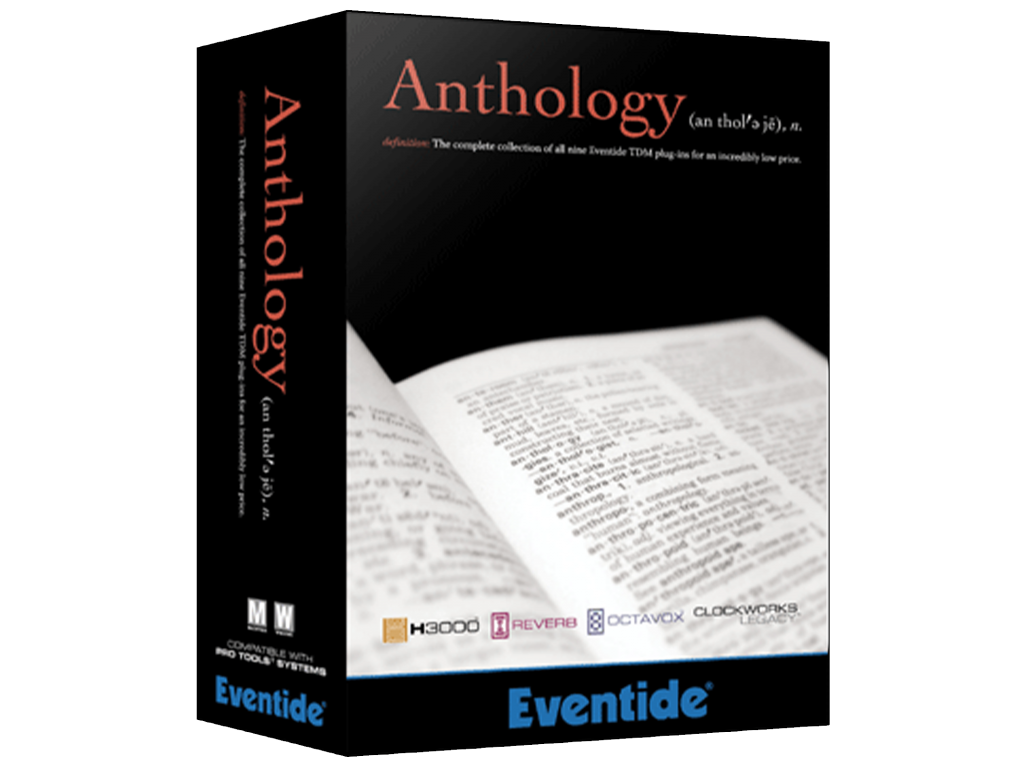

H8000FW
Building on the Ultra Harmonizer line, the H8000FW offered 1,600 effects preset algorithms tailored to music and post-production needs. The H8000FW had the new ability to record directly to your Mac or PC to capture 24-bit audio to and from its eight inputs and outputs. It featured 5.1 reverbs and delays, the option to create your own algorithms, and UltraShifter technology.
2006
H7600
The H7600 was an incredibly powerful 2-channel processor that provided 1100 preset-algorithms, 174-second sampler, and sorting capabilities for unprecedented stereo effects processing prowess. The H7600 built on the rich heritage of Eventide’s world-class H3000/DSP4000/DSP7000 series, and featured UltraShifter, award winning reverbs, tons of sampling options with time compression and expansion, pitch shift, stereo looping and more.


AUDIO HALL OF FAME

2007
H910 Harmonizer is inducted into the TEC Hall of Fame
The prestigious TEC Awards Hall Of Fame Committee inducted the H910 Harmonizer effects processor, which has been said to have turned music production on its head and ushered in a new era of music creation. The Eventide H910 Harmonizer effects processor forever changed the complexion of music enabling producers and artists to add texture to their recordings and performances in ways heretofore unimaginable.
Factor Series Pedals Launched
TimeFactor marked the first time Eventide applied their groundbreaking algorithms and effects into stompbox form and was the first release in the Factor pedal line. TimeFactor features two discrete 3-second delay lines which can function in stereo or dual mono. Delays inlcude Vintage, Tape Echo, MultiTap, Reverse, Mod, Ducked, and AutoPan.
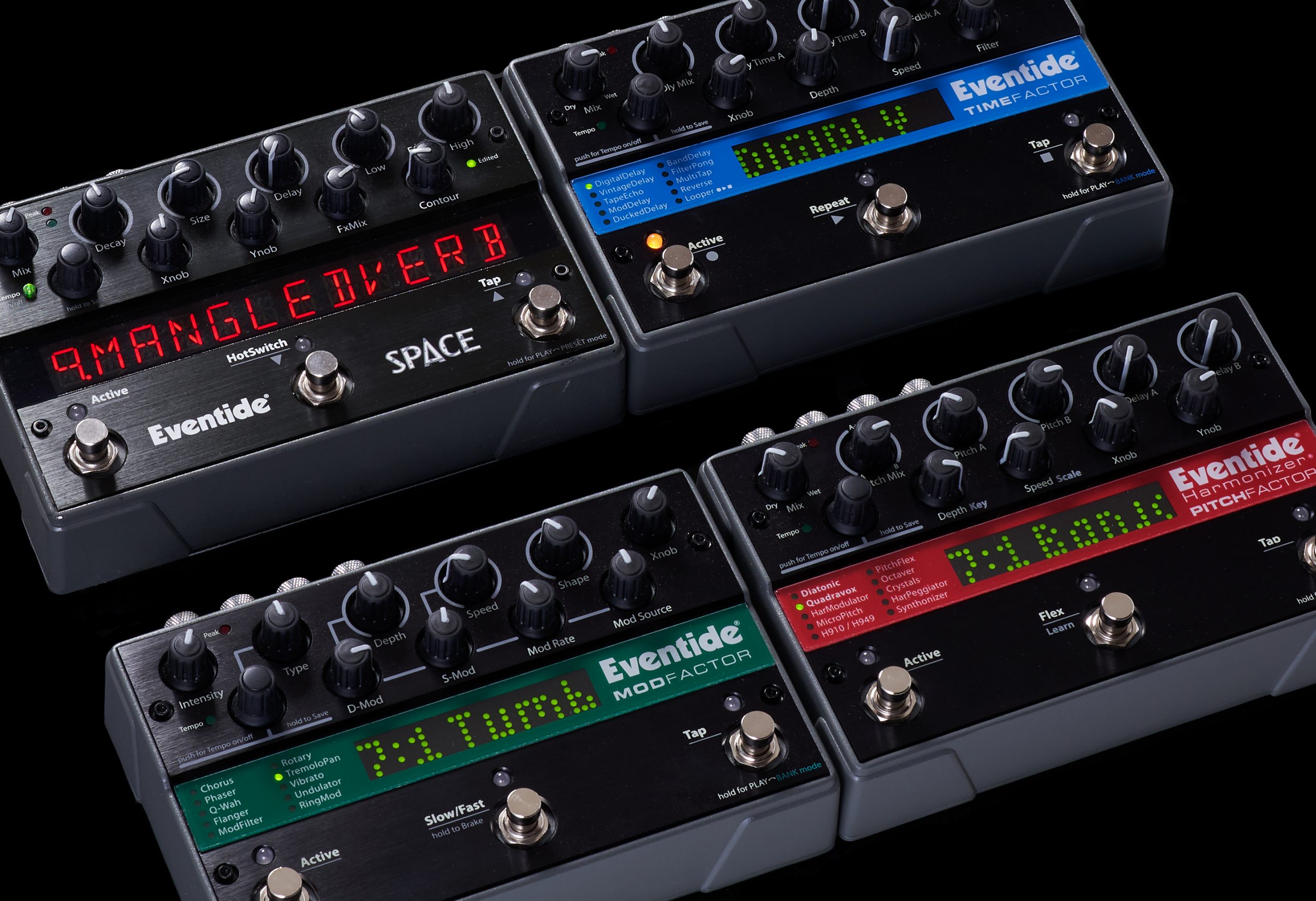
2010s


2013
H9 Harmonizer Effects Processor
The H9 Harmonizer brought Eventide stompboxes and the world of guitar effects to new levels with a vast amount of Eventide world-class studio effects right at your feet, in one pedal. H9 combined effects from all of the Factor pedals in a simple, one-knob interface that can easily connect wirelessly to iOS devices and be controlled by the H9 Control App. It also introduced new presets such as UltraTap.
2016
H3000 Ultra-Harmonizer is inducted into the TEC Hall of Fame
The prestigious TEC Awards Hall Of Fame Committee inducted the H3000 Ultra-Harmonizer, from its creation in the 1980s, through to this day, the H3000 is considered the holy grail of multi-effects and has been heard on countless records, worldwide.

AUDIO HALL OF FAME


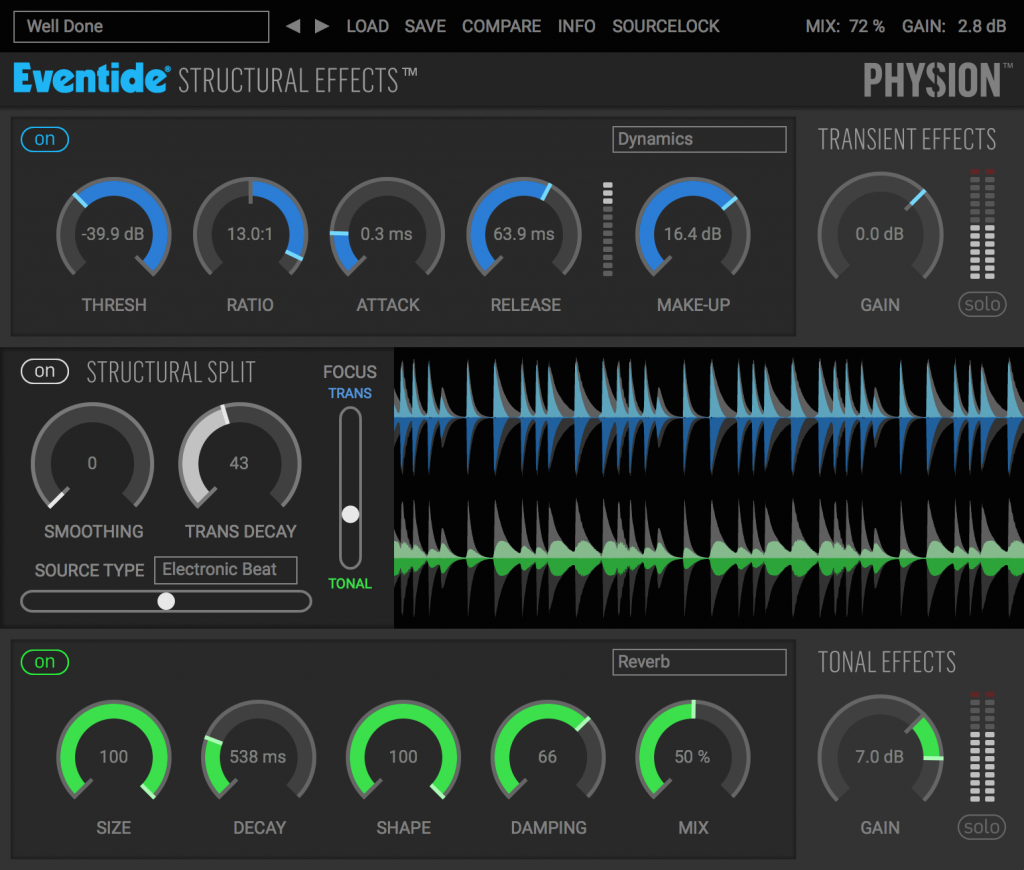
2017
Structural Effects
Physion was introduced by Eventide as the first plug-in to use our ground-breaking Structural Effects technology—Eventide’s patented method for processing audio. Physion can split sound into its transient and tonal parts, allowing users to manipulate them with Eventide’s effects and fusing them back together.
2017
H9000 Harmonizer
The H9000 was released in 2017 to feature network-ready, 16-DSP, multi-channel, rackmount audio effects processing flagship, featuring eight times the processing power of the current-generation H8000. It introduced the concept of FX CHAINS which let users connect to any set of four effects with flexible routing. In addition, the remote control application, Emote was introduced and is available for users working ‘in the box’ or over an audio network.


AUDIO HALL OF FAME

2018
DDL 1745 is inducted into the TEC Hall of Fame
The prestigious TEC Awards Hall Of Fame Committee inducted the DDL 1745, “The DDL 1745 was the first piece of digital audio equipment to make its way into recording studios” said Eventide founder, Richard Factor. “Until 1971, all signal processing equipment was analog. When Eventide introduced the DDL 1745, it ushered in the digital age. Today digital audio is ubiquitous. The DDL 1745 spearheaded that revolution.”
Tony Agnello and Richard Factor
Receive the 2018 Technical Grammy Award
Eventide was awarded the Technical GRAMMY awards for their impact on the audio industry. They are recognized for their original audio effects devices, creating the first rack-mounted special effect processors for studio use, and making sophisticated studio processors available to musicians.
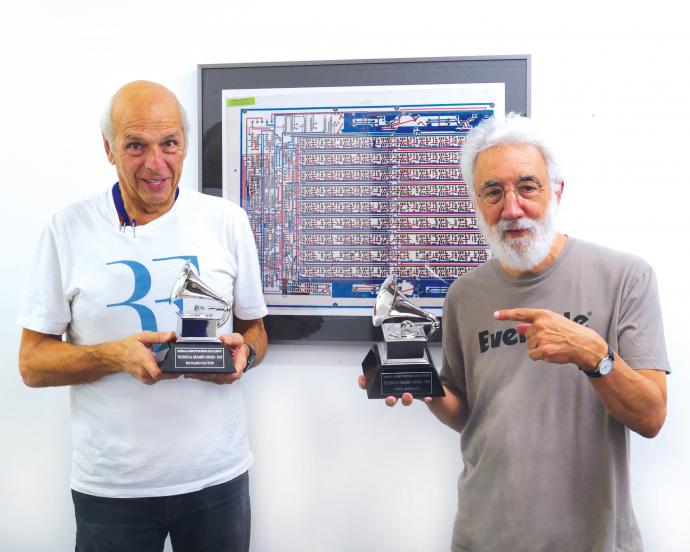

TEC AWARD WINNER

2019
H9000 wins a TEC Award in Signal Processing Hardware
The prestigious TEC Awards have given the H9000 the TEC Award in the Signal Processing Hardware category. This next generation Harmonizer is Eventide’s flagship multi-effects processor and continues the unbroken tradition of delivering industry-leading signal processing power to the pro audio community.

2020s
2020
dot9 Family is introduced
The dot9 family, including TriceraChorus, UltraTap, MicroPitch Delay, and Blackhole is introduced. Ultratap is a multi-tap effect pedal with rhythmic delays, glitchy reverbs, huge pad-like volume swells, and extraordinary modulation, offering extreme flexibilty and the ability to make new and unexpected effects. The MicroPitch Delay is a fine-resolution dual voice pitch shifter made for subtle tone fattening as well as delays for dramatic slap back effects. It is also great for creating special effects, creating depth and dimension.

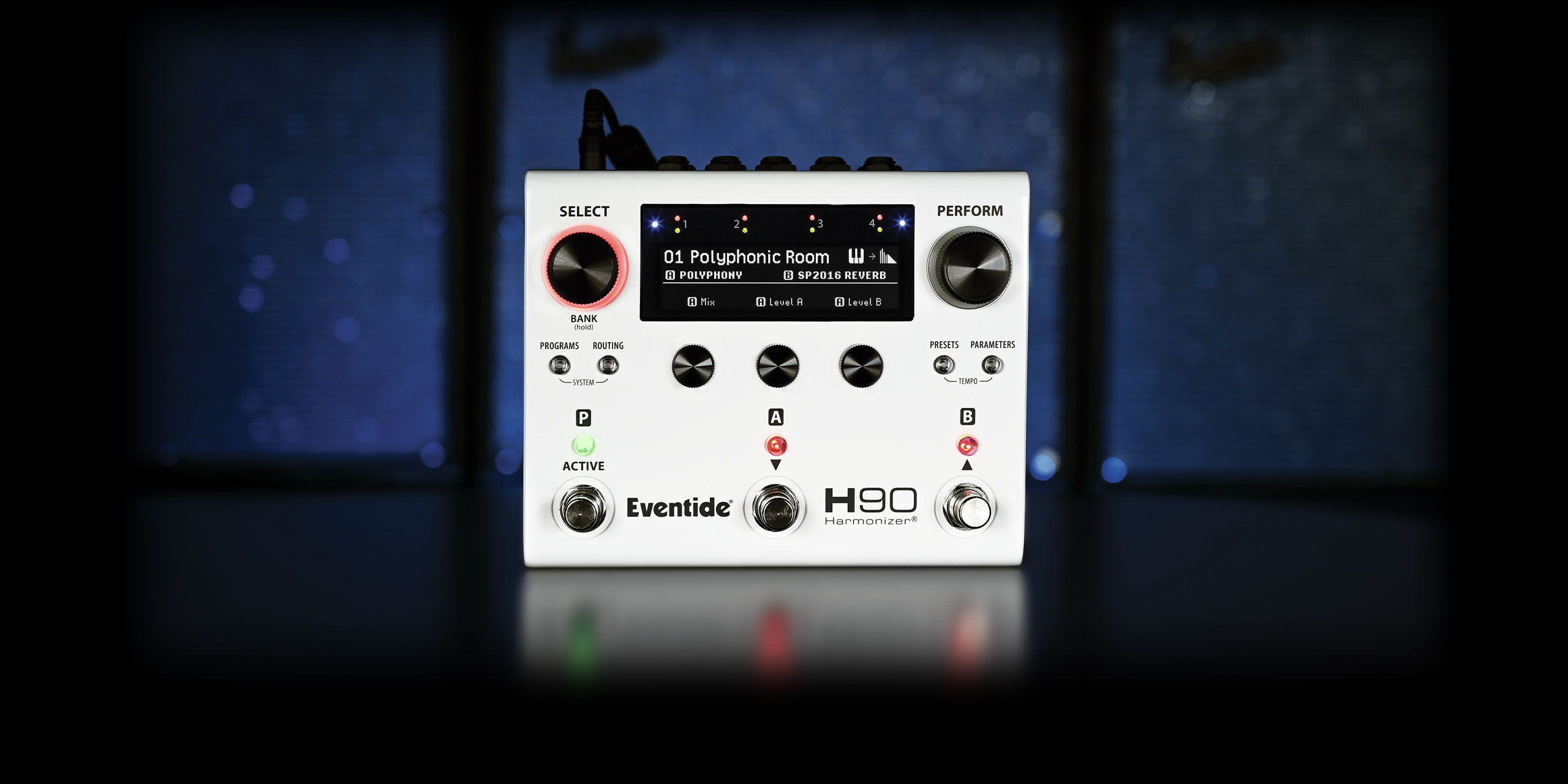
2022
H90 Harmonizer
Eventide’s latest addition to the storied Harmonizer family, the H90 Harmonizer is the next-generation multi-effects pedal. The H90 builds on the foundation of the H9 Harmonizer multi-effects processor and offers over 66 algorithms and hundreds of program combinations curated for a variety of instruments and genres. The H90 can accommodate the ongoing creation of advanced, next-gen effects never heard before.
2023
Eventide goes Immersive!
Blackhole® Immersive and MicroPitch Immersive are introduced. The plug-ins are the first of the new Immersive series, expanding the capabilities of two of Eventide’s most relied-upon effects into three-dimensional space. Designed for surround and immersive workflows, including Dolby Atmos®.



